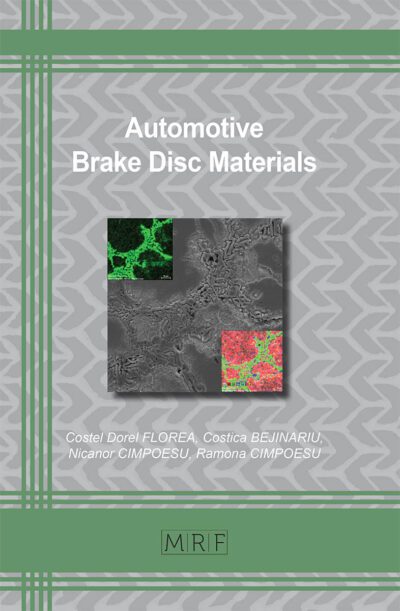Wear effects on coated tools during the alternating forming of case-hardening steel and aluminium wrought alloy
Armin Armin PIWEK, Julius PEDDINGHAUS, Johanna UHE, Kai BRUNOTTE
Abstract. A major factor for a high economic profitability in industrial bulk metal forming is the material-specific wear of the forming tools, which has a significant influence on process reproducibility. Particularly in Tailored Forming, in which hybrid material combinations are processed, narrow and sensitive process windows are characteristic. During impact extrusion of joined hybrid semi-finished workpieces made of steel and aluminium, the extrusion shoulder is subjected to combined wear phenomena. Adhesion and abrasion are superimposed, whose interactions lead to process fluctuations and premature failures in the absence of sufficient wear resistance. To investigate the yet unknown combination of the interactions, upsetting tests are carried out in cycles of 100, in which steel (AISI 5120H) and aluminium (AA-6082) are hot-formed alternately. In addition to tempered and nitrided tools, duplex coatings such as chromium nitride and titanium aluminium nitride are used to evaluate the potential of reducing the occurring wear phenomena through surface engineering methods. After the first cycles, the tools exhibit needle-shaped adhesion marks consisting of aluminium, which were subsequently transferred primarily to the steel workpieces during upsetting. Since adhesion is more present at the tool edge, an increased adhesive tendency with longer flow paths is observed. Due to the improved tribological conditions, duplex coatings minimise the wear volume on the tool and potentially on the formed workpiece with short contact times.
Keywords
Tailored Forming, Wear, Adhesion, Abrasion, Upsetting
Published online 5/7/2025, 10 pages
Copyright © 2025 by the author(s)
Published under license by Materials Research Forum LLC., Millersville PA, USA
Citation: Armin Armin PIWEK, Julius PEDDINGHAUS, Johanna UHE, Kai BRUNOTTE, Wear effects on coated tools during the alternating forming of case-hardening steel and aluminium wrought alloy, Materials Research Proceedings, Vol. 54, pp 899-908, 2025
DOI: https://doi.org/10.21741/9781644903599-96
The article was published as article 96 of the book Material Forming
![]() Content from this work may be used under the terms of the Creative Commons Attribution 3.0 license. Any further distribution of this work must maintain attribution to the author(s) and the title of the work, journal citation and DOI.
Content from this work may be used under the terms of the Creative Commons Attribution 3.0 license. Any further distribution of this work must maintain attribution to the author(s) and the title of the work, journal citation and DOI.
References
[1] ThyssenKrupp Steel AG, ThyssenKrupp Tailored Blanks bring steel to the right place, Compact 26(2) (2007) 32-33.
[2] B.-A. Behrens, J. Uhe, I. Ross et al., Tailored Forming of hybrid bulk metal components, Int. J. Mater. Form. 15 (2022) Article #42. https://doi.org/10.1007/s12289-022-01681-9
[3] P. Groche, S. Wohletz, M. Brenneis et al., Joining by forming—A review on joint mechanisms, applications and future trends, J. Mater. Process. Technol. 214(10) (2013) 1972-1994. https://doi.org/10.1016/j.jmatprotec.2013.12.022
[4] N. J. Peter, C. Gerlitzky, A. Altin et al., Atomic level bonding mechanism in steel/aluminum joints produced by cold pressure welding, Mater. Today Commun. 7 (2019) 100396. https://doi.org/10.1016/j.mtla.2019.100396
[5] C. Büdenbender, I. Ross, H. Wester et al., Numerical Investigation of an Extruded Shaft for High Temperature Applications Manufactured by Tailored Forming, In: Production at the Leading Edge of Technology, Lecture Notes in Production Engineering, Springer, Berlin, Heidelberg (2020). https://doi.org/10.1007/978-3-662-62138-7_19
[6] A. Piwek, J. Peddinghaus, J. Uhe et al., Investigation of the joining zone formation of impact extruded components by varied forming sequence and partial cooling, Mater. Res. Proc. 28 (2023) 591-600. https://doi.org/10.21741/9781644902479-64
[7] M. Hawryluk, M. Zwierzchowski, M. Marciniak et al., Phenomena and degradation mechanisms in the surface layer of die inserts used in the hot forging processes, Eng. Fail. Anal. 79 (2017) 313-329. https://doi.org/10.1016/j.engfailanal.2017.04.036
[8] B. Podgornik, Adhesive Wear Failures, J. Fail. Anal. Prev. 22 (2022) 113-138. https://doi.org/10.1007/s11668-021-01322-4
[9] G. Ficak, A. Łukaszek-Sołek, M. Hawryluk, Durability of Forging Tools Used in the Hot Closed Die Forging Process—A Review, Materials 17 (2024) 5407. https://doi.org/10.3390/ma17225407
[10] J. Smolik, “Hard Protective Layers on Forging Dies—Development and Applications,” Coatings, vol. 11, no. 376, pp. 1–18, 2021. https://doi.org/10.3390/coatings11040376
[11] H. Paschke, M. Weber, G. Braeuer et al., Optimized plasma nitriding processes for efficient wear reduction of forging dies, Arch. Civ. Mech. Eng. 12(4) (2012) 407-412. https://doi.org/10.1016/j.acme.2012.06.001
[12] M. Lamut, J. Burja, M. Terčelj et al., Degradation Processes of Two Compound Layers on Nitrided Surfaces During the Wear Test by “Block on Hot Al Cylinder”, JOM 76 (2024) 4006-4027. https://doi.org/10.1007/s11837-024-06693-1
[13] A. A. Emamverdian, Y. Sun, C. Cao et al., Current failure mechanisms and treatment methods of hot forging tools (dies) – A Review, Eng. Fail. Anal. 129 (2021) 105678. https://doi.org/10.1016/j.engfailanal.2021.105678
[14] B. Navinšek, P. Panjan, F. Gorenjak, Improvement of hot forging manufacturing with PVD and DUPLEX coatings, Surf. Coat. Technol. 137(2-3) (2001) 255-264. https://doi.org/10.1016/S0257-8972(00)01115-4
[15] B.-A. Behrens, L. Lippold, J. Puppa et al., Increasing the wear resistance of hot forging dies by PVD-deposited, titanium-based hard coatings, Forsch. Ingenieurwes. 81 (2017) 1-12. https://doi.org/10.1007/s10010-016-0209-6
[16] M. Hawryluk, Review of selected methods of increasing the life of forging tools in hot die forging processes, Arch. Civ. Mech. Eng. 16 (2016) 845-866. https://doi.org/10.1016/j.acme.2016.06.001
[17] L. Kempski, V. Waechter Dias et al., “Investigation on Different TiCN Duplex Treatments Applied to Cold Work Tool Steel for Surface Properties Improvement,” Journal of Materials Engineering and Performance, vol. 30, no. 6, pp. 4445-4457, 2021. https://doi.org/10.1007/s11665-021-05713-4
[18] T. Björk, R. Westergård, S. Hogmark, Wear of surface treated dies for aluminium extrusion—A case study, Wear 249(3-4) (2001) 316-323. https://doi.org/10.1016/S0043-1648(01)00550-6
[19] M. Pellizzari, M. Zadra, A. Molinari, Tribological properties of surface engineered hot work tool steel for aluminium extrusion dies, Surf. Eng. 23(3) (2007) 165-168. https://doi.org/10.1179/174329406X150477
[20] M. Hanson, S. Hogmark, S. Jacobson, Influence from Tool Roughness on the Risk of Work Material Adhesion and Transfer, Mater. Manuf. Process. 24(7-8) (2009) 913-917. https://doi.org/10.1080/10426910902941744














